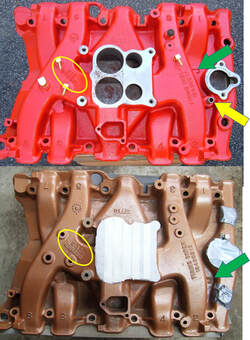Oldsmobile History
*Intake manifolds
*Oldsmobile’s W-43 Experimental 32-Valve 455 V8

|
Thanks to Joseph Padavano for contributing to this article.
Oldsmobile’s experimental W-43 engine is surrounded in myth, legend, and a tall tale or two. Let’s see if we can sort it all out.
Here at Mac’s Motor City Garage, we’re grateful to the World Wide Web for rediscovering so many wonderful stories in automotive history and bringing them to public attention. Still, we have to note that that often, the info isn’t always totally accurate—which is only natural, we suppose. After all, the internet could be described as the biggest and longest game of Telephone in history. Take this fascinating engine, for instance: the Oldsmobile W-43, an experimental V8 developed in 1967-69. Various sources have described this engine as a hemi (it isn’t) or a Can-Am engine (that was never its purpose) or a double overhead-cam design (nope). In truth, the W-43 was a conventional overhead-valve, pushrod V8, in the classic Motor City style, but with special cylinder heads and valvetrain that provided four valves per cylinder. |
|
To the average car enthusiast, a four-valve head with pushrod operation—that is, each rocker arm and pushrod operating a pair of valves—may seem like an outlandish setup, but in the diesel truck world it’s fairly commonplace (Cummins and Detroit, to name two). It looks cumbersome but it works just fine, especially where high engine speeds are not required.
The W-43 was indeed based on a standard 455 CID production block, but with some key modifications, including four-bolt main caps and special valve follower retainers that bolted into the lifter valley. The spark plugs were buried in tubes in the center of the valve covers, which no doubt fed the stories that the engine was a hemi. Bore, stroke, ,and other significant specs were identical to the production 455 CID V8. There was also an aluminum-block variant of the W-43 designated the OW-43, and the program eventually produced an experimental four-cam, 32-valve V8 based on the production engine’s architecture. |
|
With four valves per cylinder, the combustion chambers of the W-43 were not hemispherical but rather a classic pentroof layout, utilizing shallow valve angles in the Cosworth style. Intake valves were 1.75 inches in diameter and 1.375 inches on the exhaust, providing 43 percent more intake valve area than the production 455 two-valve heads. According to a feature in the May 1971 issue of Hot Rod magazine, the W-43 was good for 440 horsepower at 4600 rpm in a relatively mild state of tune. And given the improved volumetric efficiency enabled by the far greater valve area, that figure seems downright conservative.
Reportedly, the W-43 V8 was at one point considered as an across the board replacement for the standard two-valve 455 CID V8, but as we know, that never happened. Various theories have been proposed to explain why, including stricter emissions regulations and corporate infighting with the far more powerful Chevrolet division at General Motors. But as we see it, the four-valve version’s considerably greater size, weight, and manufacturing cost would have been more than sufficient to kill the program. At least two W-43 prototype engines still exist, one of them incomplete, but their current whereabouts are unclear. |
|
Link for more info...
|